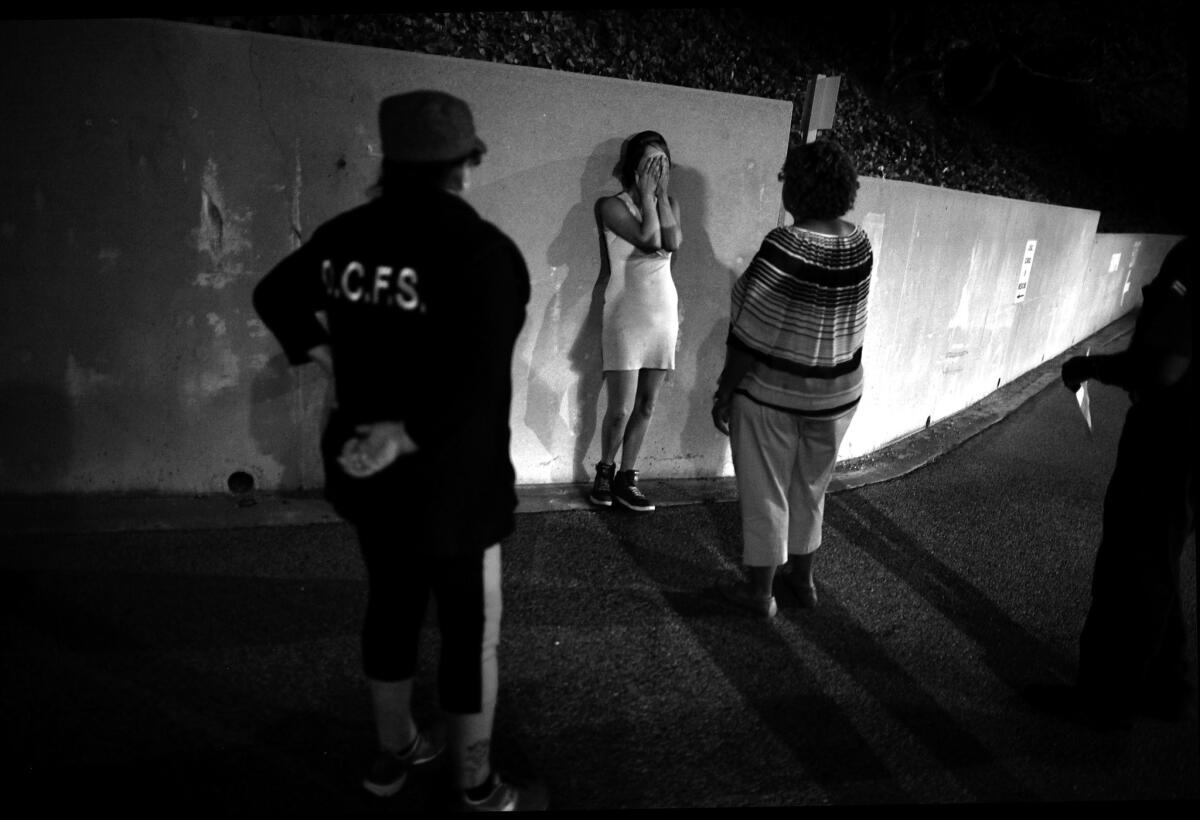L.A. County is shutting down troubled centers for foster kids with nowhere else to go

A sobbing 16-year-old yells at the social worker assigned to find her a home at a foster youth welcome center in 2015. The center is one of two that will close in the next few days.
- Share via
The waiting rooms for foster youths with nowhere else to go opened with great fanfare several years ago.
Known as Youth Welcome Centers, they were hailed by Los Angeles County officials as an important way to address the chronic shortage of foster homes, especially for children hardest to place. They were the only facilities in the county system with a no-refusal policy and quickly became a place for youths who would otherwise be homeless.
But in the next few days, the county plans to close both of its centers, acknowledging they didn’t work as intended.
As The Times reported last year, the waiting rooms had become makeshift medium- and long-term shelters where some youths spent days or weeks at a time — well beyond the 24 hours allowed under state law. In some cases, young residents were recruited into the sex-trafficking trade by other youths at the facility.
A county report commissioned in response to the article recommended that the centers — in Boyle Heights on the Los Angeles County-USC Medical Center campus — be shut down. State regulators followed with a lawsuit alleging that the centers amounted to illegal foster care facilities because of the children’s and young adults’ long stays.
In place of the waiting rooms, county supervisors have decided to outsource the care of the youths to private 72-hour shelter contractors — a plan estimated to cost $12 million annually.
County officials and experts said the failure of the waiting rooms underscores how difficult it is for L.A. County to find homes for foster youths at a time when the number of vacant beds is declining. Since 2000, the number of beds in homes of foster parents who are unrelated to the foster youths has dropped from 22,000 to 9,000.
The long-term solution, according to Department of Children and Family Services Director Philip Browning, is for state and federal officials to raise payment rates so that some foster parents can quit their jobs and provide additional attention that the highest-need children require.
A department spokesman said Browning expects state Department of Social Services and federal Medicaid officials to decide in about three months whether they will provide that money.
For now, thousands of foster youths who had relied on the welcome centers — from day-old infants to 21-year-olds — will move to five emergency shelters.
More than 5,000 children spent time at the two county-run waiting rooms last year. Many ended up there because they were the most difficult to place: newborns, older teenagers, mentally ill or medically fragile youths, as well as those who are gay, lesbian, bisexual and transgender.
These young people also tend to be the most vulnerable to the sometimes negative influence of other residents that can occur in overcrowded, impermanent welcome centers.
In November 2014, Vonie Bonjour, a transgender woman who was then 19, arrived at the waiting room. After more than 100 calls, a social worker found a home to take Bonjour. But when the social worker disclosed that she was transgender, the foster parent changed his mind. Bonjour lived in the waiting center off and on for more than a year.
“For transgenders, the system is very hard, it just destroys you,” Bonjour said one night after her arrival, as she sat eating a hamburger at a welcome center dining table. “You deal with a lot of negative people.”
Dilcia, 15, another welcome center resident, listened as if the older woman were a career counselor.
“My long-term plan? I don’t have one,” Bonjour told her. “For transgenders, it’s hard to get jobs, so we go on escort sites.”
“Hook me up,” Dilcia said.
Creating short-term emergency shelters and better-paid foster parents for longer-term housing would segregate youths such as Bonjour who are involved in sex trafficking from other youths, Browning contends. A separate facility would provide them with specialized services.
The new, emergency shelter approach also will separate the young people into four facilities according to age and how recently they entered the foster care system.
By law, each site will be allowed to keep a youth for no more than 72 hours, although officials acknowledge that they would probably be forced to exceed that deadline in some cases.
At least one architect of the existing welcome center system, Dr. Astrid Heger, warns that the new approach presents potentially disastrous risks, because the shelters will not be connected to healthcare clinics as is now the case.
Heger, director of the Violence Intervention Program at Los Angeles County-USC Medical Center, said the emergency shelters don’t have sufficient medical personnel to treat the youths and determine whether they are victims of abuse — meaning that some could wind up back with abusive parents.
She added that the new sites will discourage homeless youths from dropping by for showers and meals, which gives staff members opportunities to offer them additional help, she said.
Heger has advocated for keeping the welcome centers but moving the most difficult young people to a more suitable facility.
The approved plan calls for Heger’s physicians to continue to screen youths before they’re sent to the emergency shelters. The time at the medical center will be much more limited, however. Heger said she worries that worn-out social workers will sometimes skip the medical visits as they transport the young people to far-flung shelters in Alhambra, Baldwin Hills and other locations.
“Kids might die again,” she said. “They’re going to be invisible again.”
The Los Angeles County Board of Supervisors, which has jurisdiction over child welfare, decided against taking a public vote on the plan.
Just two years ago, Supervisor Hilda Solis was so enthusiastic about the waiting rooms that she called one a symbol for her own pledge to be a “champion for children.”
By then, however, problems were developing.
Mike Ross, the center’s chief, worked to establish a therapeutic environment with peer counselors and mental health professionals providing “unconditional positive regard” to the youths. But, he said, the waiting rooms’ crushing pressures undermined those efforts.
Last year, several teenagers rushed the armed guard stationed at the front door at the older youths’ welcome center and attempted to wrestle a gun away, Children and Family Services officials said.
Staff members staged a sickout after the incident to highlight concerns about their safety, and a sheriff’s deputy was permanently assigned to the waiting room. Since then, disciplinary problems have been handled by law enforcement.
Some of the young people found the centers that were supposed to be their salvation worse than other bad alternatives.
After being convicted of domestic violence, Bonjour, for example, told a judge that she would rather serve time in jail than return to a life of sporadic stays at the welcome center.
Now 21 and back on the streets, she finds herself struggling, addicted to methamphetamine, and wondering what kind of life she might have had if the county had found her a foster home.
“What can I do to possibly get back to the old Vonie, you know? It is really embarrassing because I didn’t see my life ending up like this. I swear to you.”
Twitter: @gtherolf
See more of our top stories on Facebook >>
ALSO
Instead of record rains, L.A. gets the hottest February on record
After violent KKK brawl, marchers in Anaheim try to ‘fight fire with love and compassion’
On The Streets: Living ‘homefree’ in a van in Venice
More to Read
Sign up for Essential California
The most important California stories and recommendations in your inbox every morning.
You may occasionally receive promotional content from the Los Angeles Times.











